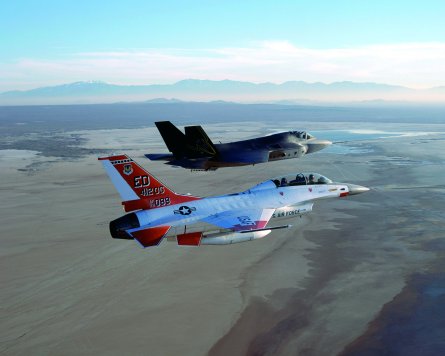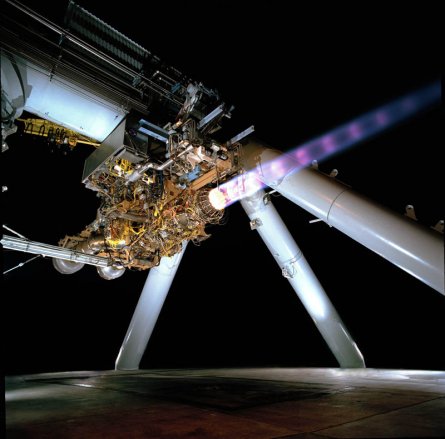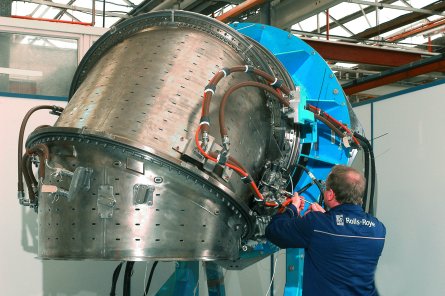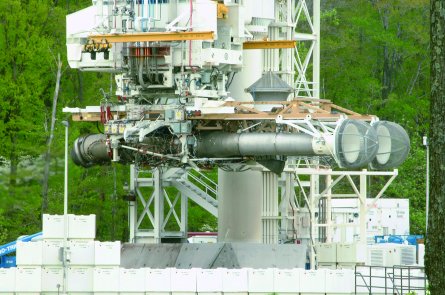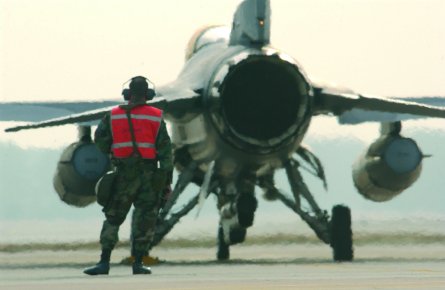Guy Norris / Los Angeles
|
| Contracts to power the F-16 (fore-ground) were contested annually. Will the F-35 (back-ground) follow suit? |
In US defence budget terms it is unusual for a contract worth just $400 million to prompt outbreaks of shouting, top-level Congressional hearings and even questions over the fabled US-UK “special relationship”.
Yet this is what has been happening in the debate over funding the alternative F136 engine for the Lockheed Martin F-35 Joint Strike Fighter (JSF) – a debate in which the ferocity seems to have become disproportionate, at least in the short term, to the amount of money involved. In a nutshell, it means the difference between whether or not there will be a competing engine for the Pratt & Whitney F135-powered F-35.
In the long run, however, the alternate engine decision will not only reveal which companies will be in competition for a potential $60-100 billion market, but also, it has been argued, the long-term future of the advanced military propulsion industrial base in the USA and UK. It is a complex story that might come to an abrupt end this year if the funding vanishes and the General Electric Rolls-Royce Fighter Engine Team (FET) does not survive long enough to win its first competitive contract.
The FET has had to fight before, but has never been as close to the brink as this. The latest threat began when the US Department of Defense, squeezed by massive spending to support operations in Iraq and Afghanistan on one side, and by the threat of JSF cost overruns on the other, sought savings wherever it could in its future years defence plan (FYDP). As a result, its 2007 defence budget proposed axing the competing F136 engine to save an estimated $1.8 billion.
Stunned, GE rallied quickly to lead a rearguard action to keep the F136 alive and revive what it says is the original mandate from Congress that initiated the competitive engine programme itself in 1996. Two years later Congress formally directed the DoD ensure the JSF programme “contains sufficient funding to carry out an alternate engine development programme that includes flight qualification of an alternate engine in a JSF airframe”.
Pratt & Whitney, meanwhile, marched up to Capitol Hill and has been there ever since acting “in a support role and trying to put the facts in front of the staffers”, says the company’s vice-president of international programmes and business development, William Begert. “There are a lot of myths obfuscating the facts over cost, reliability and safety. We take the President’s budget as a compliment to Pratt & Whitney and its efforts so far, and see it as a vote of confidence from the US Navy, Marines and Air Force, as well as the Pentagon, in what we’re doing.”
Congressional intent
Russ Sparks, the president of military systems at GE Aviation on hearing of the late April decision by the House Armed Services Committee to recommend reinstating the $408 million in FY07 funding for the competitive engine, describes the vote “as an enforcement of the long-range Congressional intent for the past decade”. Even with the more recent approval by the parallel Senate Armed Services Committee in the bag, Sparks reiterates the effort still has to clear the hurdles of the House and Senate Appropriations Committees and final FY07 budget approval process. “It won’t be until sometime in September/October before we know for sure where we are,” he says.
|
| Pratt & Whitney has a three-year lead in developing the F135 |
Sparks also believes his role is as much about reminding the DoD (and some elements within Congress) that “this is a not a winner-take-all situation. I’m not trying to have the engine contest today. I want to keep my place so that allows us to have the real competition next decade.” He adds that “there never has been an engine competition for JSF. Pratt & Whitney won the ATF [Advanced Tactical Fighter – later F-22] fair and square, but the F119 [later F135] was chosen for the JSF because it was the only engine available at the time.”
Begert counters by saying that the pursuit of a sole-source engine policy is nothing unusual. “Frankly, that’s all there have been in the history of jet engines. The F100 [versus the F110] is the only one example of anything different, and this is an aberration. Even then, the two F-16 [versions] are different aircraft, and the airframe is not interchangeable.”
Although backing Congressional belief that “competition is good for the country”, there is nothing altruistic in Sparks’ intent. “I want to compete as early as Lot 3, and if we get restored we’ll look for opportunities to accelerate the programme,” he says. “The sooner the better for our business case, and for us the STOVL [short take-off and vertical landing] variant could be first because of the UK/US Harrier replacement. So I want to compete for the STOVL, and I want to compete in Lot 3.”
Under the current JSF plan, long lead contracts for Lot 3 (covering around 68 engines) are due to be let around February 2008, with first deliveries to Lockheed beginning around May 2010 and running until mid-2011.
Lot 4 competition
Lot 4, which until now has always been thought of as the first batch for which the F136 could realistically be expected to compete, is due to start with long lead contracts for up to 42 engines in February 2009, with initial deliveries to Lockheed starting in June 2011.
Sparks’ push to get on board earlier makes business sense for more than the obvious reason. One of the key DoD arguments for axing the alternate engine is that its break-even analysis suggested such a programme must generate at least 15-20% cost savings to be justifiable. As these cost savings from competitive pricing between the two engine suppliers can only be amortised across the number of engines sold and delivered, GE says the quicker the F136 is available to compete, the less of a disadvantage it will have. As it stands, the F135 has a three-year lead over the F136, and any potential cost benefits are believed to be at least a decade away. The up-front costs, however, are staring DoD in the face.
The break-even analysis is one of the most controversial areas. The DoD analysis, used by US deputy defence secretary Gordon England to back his assertion that a “second source would not yield programme cost savings”, indicated that the Pentagon planned to buy 3,036 engines over 16 years. To recoup the $2.8 billion cost of the F136 system development and demonstration (SDD), plus an added $700 million for increased dual-source support costs and other factors, the DoD estimated it must generate savings of at least 20% to almost break even by the projected end of the F-35 production run in around 2026-7.
|
| Rolls-Royce is supplying lift-system components for both engines |
Daunting estimates
P&W’s estimates are even more daunting as it includes the $1.08 billion already spent on the F136 pre-SDD. While its predictions for F-35 sales are more optimistic at around 4,000 including foreign sales, P&W estimates the total savings the DoD will need to get back to break even on the competing engine is $3.5 billion. P&W, based on the amortised pay-back over the 2,000 engines that it believes the FET could win, calculates the F136 would need to offer up to $1.7 million of savings per engine. To heap further misery on the F136 business case, P&W’s analysis is that the true DoD costs will be higher, and therefore harder to reach a break-even on, because upgrade and component improvement costs will have to be doubled to support two engines.
“You have got to make heroic efforts before you get to those sorts of numbers,” says Begert. “Three thousand engines is the programme of record, and even that could go down if prices go up. USAF officers have said to me they are very comfortable seeing the alternate engine cancelled if it means forgoing the luxury of competition versus the number of tails. You’d like to have two of everything, sure, but not everyone has unlimited funds. The arithmetic just doesn‘t add up.”
The GE analysis, however, counters by claiming the DoD/P&W engine numbers are significantly short of the mark, and that the true costs will be amortised over a much larger engine fleet.
Based on the stated present US and international requirements for more than 3,700 F-35s, plus historical analysis of spare engines and parts sales, it predicts a staggeringly different 8,400 engines could be acquired over the life of the programme. It also points out that P&W’s analysis should include all 4,000 engines as it believes competition would cut the cost of both fleets, not just the F136.
For reference all parties turn to “the Great Engine War” of the 1980-90 period when P&W and GE fought tooth and nail to power the McDonnell Douglas (now Boeing) F-15 and Lockheed F-16, with contests run annually from 1984 to 1994 to see which would win the US Air Force contract. The war is still waged to this day in the international marketplace, and looks set to continue while both aircraft models remain in production.
The highly unusual competitive acquisition strategy for the USAF was seen at the time as not only being innovative and cost-saving for the DoD, but also ultimately good for the engine makers themselves as each worked hard to improve their F100 and F110 engines over the years. The actual savings of the contest are also now subject to dispute, the debate being complicated by estimates of competitive savings on actual procurement and those made in the equally hard fought area of operations and support.
To the surprise of some industry officials, the DoD supported its break-even analysis by saying that the F100/F110 contest produced only “minimum cost benefits”. Although P&W previously went on record with estimated savings of around $3 billion (over a 20-year life-cycle of the improved F100 and F110 versus an original F100 over the same period), it now says that on closer analysis “there is no documented evidence that in the Great Engine War that the DoD saved a dime,” says Begert. “Maybe if you assume this, and assume that you’ll get something, but if you look at real costs on an apples-to-apples basis, you don’t save a dime.”
Not surprisingly GE comes up with a startlingly different assessment, and puts the savings figure closer to $3.5 billion.
P&W, meanwhile, is in a strange position as lead developer. On one hand it is marching ahead of schedule developing what appears to be an exemplary fighter engine, while on the other it has willingly obeyed orders to meet up with its competition in a spirit of “co-opetition” to ensure the F136 drops neatly into the same hole in the F-35 as the F135. It has also, at the same time, wasted no time in supporting the DoD’s analysis that a competing engine is wasteful and unnecessary.
P&W F135 director of international programmes Ed O’Donnell believes the continuing success of the engine’s smooth development is its own best advertisement. “We can’t assume or do anything based on another’s performance, and the best thing we can do is make sure we’re prepared to support the customer, no matter what happens.” O’Donnell adds that in the build-up to LRIP 2 and 3 “part of that will be looking at trigger points for increasing production. We will be prepared to deliver all the engines we have to.” The planned work on the company’s Middletown, Connecticut F135 moving assembly line is aimed at a rate of around 100 engines a year. Between the F135 and F-22’s F119 P&W expects to deliver just over 200 engines a year by the 2008-10 period.
GE argues that this concentration on the world’s two most advanced, high-end performance military combat engines on one line is another element in the dual- source debate. Although reliability and safety for all engines has unquestionably improved, GE argues that by putting its eggs in one basket the DoD may be making itself vulnerable to disruptions caused by any threats – natural or man-made – to the supply chain. It also points out that the JSF replaces many aircraft in many roles. At the height of the Great Engine War, GE says US forces flew 11 major combat aircraft types, some of which could substitute for others in tactical or strategic roles if needed.
Any engine-related issues to the JSF, GE argues, could therefore be far more potentially threatening to national capability. P&W counters that the virtually flawless performance of the F119, added to the advanced design and analysis tools available for the directly derived F135 make this threat a virtual non-issue.
Single-engine risk
GE also argues that the single-engined F-35 is naturally more vulnerable to potential operational issues than sole-sourced, but twin-engined types such as the F-22 or F414-powered F/A-18E/F. The argument assumes a little more gravity when it comes to the F-35B STOVL variant, given the accident record of the single-engined R-R Pegasus-powered Harrier/AV-8B over the decades. GE believes the complexities of the STOVL application alone may convince the DoD to reverse its sole-source course. Sparks concurs that the argument is “relevant”, but argues the real case lies more in potential growth and additional thrust needs. “As they go into service, they will fly them to their capability and the engines will evolve a lot faster if there are two teams.”
|
| GE/R-R want to accelerate the F136 to increase the benefits of competition |
In the longer term, GE argues the sole-source option poses a threat to the over-arching engineering capabilities of the company in the high-thrust arena, making it an industrial base issue. “JSF is the only game in town and if you don’t have a meaningful development part in that programme, our view is that GE would become disabled. I’m not saying if we don’t win we’ll go out of business – absolutely not. We have got our turboshaft business and we’re okay on the smaller fighters, but there are some engineering disciplines that are unique to high-performance engines. We are worried about losing the engineering skills for the future,” says Sparks.
Another issue, even less easy to gauge, is that of the international aspect of the sole-source engine debate and, particularly, the impact on the UK and its continuing support and commitment to the F-35. Some measure of the importance of the issue came when UK prime minister Tony Blair made direct contact with US president George Bush over the F136 budget cut, while UK defence procurement minister Lord Drayson criticised the DoD for not warning it about the impending action.
Although he said the UK wishes to see the engine funded, Grayson said it will not leave the programme because of the move, which he described as “perplexing” after having seen Congress award the FET a $2.4 billion contract the previous August to develop the engine.
The former RAF chief of air staff ACM Sir Jock Stirrup, now the UK chief of defence staff, has made his feelings clear on the issue. During a 18 January briefing he said: “The alternate engine has more thrust and more thrust potential. As a pilot you can never have enough power.”
UK impact
Sparks says the MoD “had the belief since they invested $2 billion in the programme, they should be consulted on major changes like that, particularly since they’d assumed there would be two engines”. The DoD argument was that it was dealing with a US budget issue.
The impact on the UK industrial base is also a factor, given the larger involvement (40%) of R-R in the F136, versus the F135. Although unable to offer R-R much in the way of core work since the F119-derived F135 was already well designed and understood, P&W has moved positively to embrace the UK engine maker’s key strengths in STOVL propulsion system design. In February, P&W and R-R signed a memorandum of understanding (MoU) defining future collaboration on the F135 propulsion system, which is limited to the STOVL variant through the production and sustainment phase of the JSF programme. Under the agreement, R-R will maintain its current lift system component responsibilities beyond SDD into production and support. The UK company produces the lift fan, three-bearing swivel module and roll posts as a subcontractor to P&W.
|
| The benefits of the F-16 engine competition are being called into question |
“We’ve tried very hard and R-R has content on the vertical lift system for the STOVL. They are team mates of ours and they are a key supplier and we’re working very closely,” says Begert, who says UK industrial suppliers as a whole to the JSF stand to gain $25 billion over the expected life of the programme as it currently stands.
However, the wider international perspective, he says, is less concerned about the engine than the whole programme. “Seven of the eight [international partners] have testified or said they’re concerned about cost and schedule, and so are we. The main thing the British were discussing [at the hearings] was technology transfer and once they settled on that, the engine side went a bit quiet.”
Summer battle
As the two protagonists prepare to slug it out through another hot summer on Capitol Hill, both remain optimistic. Begert says language in the latest committee calls for a “detailed study on how these costs will be saved. I think that’s great news for P&W and the DoD. That’s the best thing that could have come out of this, and I’m very confident of its findings. The number one thing we can do to control our own destiny is our performance on this programme – if we stumble we deserve what we get.”
Sparks is just as confident the same study will be positive for the F136 and underline the economic grounds for giving the FET a chance to compete. “Is it in the interests of the country to have a sole source award of this scale without having a competition? I don’t think so,” he adds.
Source: Flight International





















